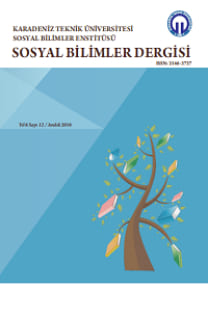İSTİHDAM YARATMAYAN BÜYÜME: ALT SEKTÖRLER BAZINDA BİR ARAŞTIRMA
Bu çalışmada Türkiye’de istihdam yaratmayan büyüme olgusu hem genel ekonomi düzeyinde hem de tarım, sanayi ve hizmetler gibi ekonominin temel sektörleri bazında 1988-2015 dönemi itibariyle istihdam esneklik katsayıları kapsamında araştırılmıştır. Temel sektörlere ek olarak istihdam esneklikleri madencilik, imalat sanayi, elektrik, gaz ve su, inşaat, ulaştırma ve ticaret gibi ikinci derece alt sektörler bazında da tahmin edilmiştir. Çalışmadan elde edilen bulgulara göre en yüksek istihdam esneklik katsayısı inşaat sektörüne aittir. Bu katsayı inşaat sektörü için gayri safi yurtiçi hasılanın trenddensapmasında meydana gelen yüzde 1’lik bir artışın istihdamın trendden sapmasında yüzde 1.55’lik artışa neden olduğunu göstermektedir. Bulgular ayrıca pozitif/negatif çıktı açıklarının çoğu sektörler için istihdam üzerinde farklı etkilere sahip olmadığını göstermektedir.
Anahtar Kelimeler:
İstihdam Yaratmayan Büyüme, İstihdam Esnekliği, Asimetrik Etki
JOBLESS GROWTH: A RESEARCH ON SUB-SECTORS
In this study, it was investigated the jobless economic growth in Turkey based on both the general level of economy and the main sectors such as agriculture, industry and services at the period of 1988-2015 in the context of employment elasticity coefficients. In addition to the main sectors, employment elasticities were estimated on the order of secondary sub-sectors such as mining, manufacturing industry, electricity, gas and water, construction, transportation and trade. According to findings from this study, the construction sector has the highest employment elasticity coefficient. This coefficient indicates that 1 percentage increase in the deviation from trend of gross domestic product causes 1.55 percentage increase in the deviation from trend of employment for construction sector. The results show also that positive/negative output gaps have not different effects on employment for many sectors.
Keywords:
Jobless Growth, Employment Elasticity, Asymmetric Effect,
___
- Akkemik, K. A. (2007). The Response of Employment to GDP Growth in Turkey: An Econometric Estimation, Applied Econometrics and International Development, 7(1), 65-74.
- Aksoy, E. (2013). Relationships between Employment and Growth from Industrial Perspective by Considering Employment Incentives: The Case of Turkey, International Journal of Economics and Financial Issues, 3(1), 74.
- Altuntepe, N. & Güner, T. (2013). Türkiye'de İstihdam-Büyüme İlişkisinin Analizi (1988-2011), Uluslararası Alanya İşletme Fakültesi Dergisi, 5(1), 73-84.
- Barışık, S., Çevik, E. İ. & Kırcı Çevik, N. (2010). Türkiye’de Okun Yasası, Asimetri İlişkisi ve İstihdam Yaratmayan Büyüme: Markov-Switching Yaklaşımı, Maliye Dergisi, 159, 88-102.
- Beaton, K. (2010). Time Variation in Okun’s Law: A Canada and U.S. Comparison, Bank of Canada Working Paper, 7, 1-17.
- Dickey, D. & Fuller, W. (1979). Distribution of the Estimators for Autoregressive Time Series with A Unit Root, Journal of The American Statistical Association, 74, 427-431.
- Döpke, J. (2001). The “Employment Intensity” of Growth in Europe, Kiel Working Paper, 1021, 1-46.
- Erdem, H. F. & Yamak, Y. (2016). Measuring the Optimal Macroeconomic Uncertainty Index for Turkey, Economic Annals, 61(210), 7-22.
- Ertuğrul, H. M. & Uçak, A. (2013). Ekonomik Büyüme İstihdam İlişkisi: Türkiye için Dinamik Bir Uygulama, International Journal of Human Sciences, 10(1), 661-675.
- Hanusch, M. (2012). Jobless Growth? Okun’s Law in East Asia, Policy Research Working Paper, 6156, 1-13.
- Kara, M. & Duruel, M. (2005). Türkiye’de Ekonomik Büyümenin İstihdam Yaratamama Sorunu, Sosyal Siyaset Konferansları Dergisi, 50, 367-396.
- Kapsos, S. (2005). The Employment Intensity of growth: Trends and Macroeconomic Determinants, International Labour Office, Employment Strategy Papers, 12, 1-55.
- Korkmaz, S. & Yılgör, M. (2010). 2001 Krizinden Sonra Türkiye’de Büyüme ve İstihdam Arasındaki İlişki, Yönetim ve Ekonomi Araştırmaları Dergisi, 8(14), 169-176.
- Lee, J. (2000). The Robustness of Okun's Law: Evidence from OECD Countries, Journal of Macroeconomics, 22, 331-356.
- Moazzami, B. & Dadgostar, B. (2009). Okun’s Law Revisited: Evidence from OECD Countries, International Business & Economics Research Journal, 8(8), 21-24.
- Murat, S. & Yılmaz Eser, B. (2013). Türkiye’de Ekonomik Büyüme ve İstihdam İlişkisi: İstihdam Yaratmayan Büyüme Olgusunun Geçerliliği, Hak İş Uluslararası Emek ve Toplum Dergisi, 2(3) 92-123.
- Muratoğlu, Y. (2011). Büyüme İstihdam Arasındaki İlişki Türkiye Örneği, International Conference On Eurasian Economies, 167-173.
- Newey, W. K. & West, K. D. (1987). A Simple, Positive Semi-Definite, Heteroskedasticity and Autocorrelation Consistent Covariance Matrix. Econometrica, 55: 703-708.
- N’Guessan, J. C. F. (2006). Asymmetric Adjustment of the Equilibrium Relationship between Employment and Economic Growth in Côte d’Ivoire: A Threshold Modeling Approach, 11th Annual Conference of the African Econometrics Society, Dakar, Senegal.
- Okun, A. M. (1962). Potential GNP: Its Measurement and Significance, In American Statistical Association. Proceedings of the Business and Economic Statistics Section.
- Özdemir, B. K. & Yıldırım, S. (2015). Türkiye'de Ekonomik Büyüme ve İstihdam Arasındaki Nedensellik İlişkisinin Analizi: Özçıkarımlı Dalgacık Yaklaşımı, Dumlupınar Üniversitesi Sosyal Bilimler Dergisi, 38, 97-116.
- Prachowny, M. F. J. (1993). Okun's Law: Theoretical Foundations and Revised Estimates, Review of Economics and Statistics, 75, 331–336.
- Sögner, L. & Stiassny, A. (2000). A Cross-Country Study on Okun’s Law, Growth and Employment in Europe, Sustainability and Competitiveness Working Paper, 13, 1-24.
- Tuncer, İ. & Altıok, M. (2012). Türkiye İmalat Sanayinde Büyüme ve Büyümenin İstihdam Yoğunluğu: 1980-2008 Dönemi, Çalışma İlişkileri Dergisi, 1(3), 1-22.
- Ulusoy, A., Yamak, R. & Şahingöz, B. (2016). Faiz Dışı Dengenin Ekonomik Büyüme ve İşsizlik Üzerine Etkisi, Ekonomi Bilimleri Dergisi, 8(1), 1-33.
- Yamak, N. & Yamak, R. (1999). Türkiye’de İşsizlik Oranı ile İşgücüne Katılma Oranı Arasındaki İlişki, Kamu-İş İş Hukuku ve İktisat Dergisi, 5(1), 17-27.
- Yeldan, E. & Ercan, H. (2011). Growth, Employment Policies and Economic Linkages: Turkey, International Labour Organization The Employment Working Papers, 84, 1-51.
- ISSN: 2146-3727
- Yayın Aralığı: Yılda 2 Sayı
- Başlangıç: 2011
- Yayıncı: Karadeniz Teknik Üniversitesi Sosyal Bilimler Enstitüsü
Sayıdaki Diğer Makaleler
ÖRGÜT KÜLTÜRÜNÜN DİNAMİK YETENEKLERE ETKİSİ
İSTİHDAM YARATMAYAN BÜYÜME: ALT SEKTÖRLER BAZINDA BİR ARAŞTIRMA
ZEHRA ABDİOĞLU, NİLCAN ALBAYRAK
AVRUPA BİRLİĞİ VE TÜRKİYE’DE İHRACATA YÖNELİK DEVLET YARDIMLARI
SÜRDÜRÜLEBİLİR KALKINMA 2030 GÜNDEMİ BAĞLAMINDA ÇALIŞMA HAYATINDA CİNSİYETE DAYALI AYRIMCILIK
TÜRKİYE’DE AR-GE HARCAMALARININ FİRMA KARLILIĞINA ETKİSİ
TOPLUMSAL GÜVENLİĞİN SAĞLANMASI KAPSAMINDA NEFRET SUÇLARININ ÖNLENMESİNDE İLETİŞİMİN ROLÜ
FRANSA’DA YERELLEŞME REFORMLARI: TÜRKİYE ÜZERİNDEN BİR DEĞERLENDİRME
KAZANÇ TEMELLİ DEĞİŞKENLERİN DENETİM RİSKİ ÜZERİNDEKİ ETKİLERİNİN DEĞERLENDİRİLMESİ
ÖZEL HASTANELERİN HİZMET PAZARLAMASINDA YENİ TREND: DOĞUM PAKETLERİ
